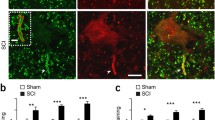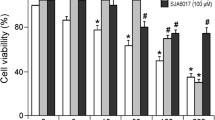Abstract
Microdialysis perfusion of α-amino-3-hydroxy-5-methyl-4-isoxazole propionic acid (AMPA) in rat lumbar spinal cord produces severe motoneuron damage and consequently hindlimb paralysis. Here we studied the time course of the AMPA-induced neurodegenerative changes and motor alterations, and the protective effect of leupeptin, an inhibitor of calpain, a Ca2+-activated protease. Paralysis occurs at 4–6 h after AMPA perfusion, but cresyl violet staining showed that motoneuron damage starts at about 3 h and progresses until reaching 50% neuronal loss at 6 h and 90% loss at 12 h. In contrast, choline acetyltransferase (ChAT) immunohistochemistry revealed that the enzyme is already decreased at 30 min after AMPA perfusion and practically disappears at 3 h. Microdialysis coperfusion of leupeptin with AMPA prevented the motor alterations and paralysis and remarkably reduced both the decrement in ChAT immunoreactivity and the loss of motoneurons. We conclude that an increased Ca2+ influx through Ca2+-permeable AMPA receptors activates calpain, and as a consequence ChAT content decreases earlier than other Ca2+-dependent processes, including the proteolytic activity of calpain, cause the death of motoneurons.




Similar content being viewed by others
References
Rosen DR, Siddique T, Patterson D, Figlewicz DA, Sapp P, Hentati A, Donaldson D, Goto J, O’Regan JP, Deng HX et al (1993) Mutations in Cu/Zn superoxide dismutase gene are associated with familial amyotrophic lateral sclerosis. Nature 362:59–62
Carriedo SG, Yin HZ, Weiss JH (1996) Motor neurons are selectively vulnerable to AMPA/kainate receptor-mediated injury in vitro. J Neurosci 16:4069–4079
Van Den Bosch L, Vandenberghe W, Klaassen H, Van Houtte E, Robberecht W (2000) Ca2+-permeable AMPA receptors and selective vulnerability of motor neurons. J Neurol Sci 180:29–34
Corona JC, Tapia R (2004) AMPA receptor activation, but not the accumulation of endogenous extracellular glutamate, induces paralysis and motor neuron death in rat spinal cord in vivo. J Neurochem 89:988–997
Vandenberghe W, Robberecht W, Brorson JR (2000) AMPA receptor calcium permeability, GluR2 expression, and selective motoneuron vulnerability. J Neurosci 20:123–132
Corona JC, Tapia R (2007) Ca2+-permeable AMPA receptors and intracellular Ca2+ determine motoneuron vulnerability in rat spinal cord in vivo. Neuropharmacology 52:1219–1228
Corona JC, Tovar-y-Romo LB, Tapia R (2007) Glutamate excitotoxicity and therapeutic targets for amyotrophic lateral sclerosis. Expert Opin Ther Targets 11:1415–1428
Shields DC, Ray SK, Gantt-Wilford G, Banik NL (1998) Calpain expression varies among different rat and bovine central nervous system regions. J Neurosci Res 53:482–489
Bi X, Chen J, Baudry M (1998) Calpain-mediated proteolysis of GluR1 subunits in organotypic hippocampal cultures following kainic acid treatment. Brain Res 781:355–357
Guttmann RP, Sokol S, Baker DL, Simpkins KL, Dong Y, Lynch DR (2002) Proteolysis of the N-methyl-d-aspartate receptor by calpain in situ. J Pharmacol Exp Ther 302:1023–1030
Araujo IM, Verdasca MJ, Leal EC, Bahr BA, Ambrosio AF, Carvalho AP, Carvalho CM (2004) Early calpain-mediated proteolysis following AMPA receptor activation compromises neuronal survival in cultured hippocampal neurons. J Neurochem 91:1322–1331
Ray SK, Banik NL (2003) Calpain and its involvement in the pathophysiology of CNS injuries and diseases: therapeutic potential of calpain inhibitors for prevention of neurodegeneration. Curr Drug Targets CNS Neurol Disord 2:173–189
Araujo IM, Carvalho CM (2005) Role of nitric oxide and calpain activation in neuronal death and survival. Curr Drug Targets CNS Neurol Disord 4:319–324
Banik NL, Shields DC, Ray S, Davis B, Matzelle D, Wilford G, Hogan EL (1998) Role of calpain in spinal cord injury: effects of calpain and free radical inhibitors. Ann NY Acad Sci 844:131–137
McCollum AT, Jafarifar F, Lynn BC, Agu RU, Stinchcomb AL, Wang S, Chen Q, Guttmann RP (2006) Inhibition of calpain-mediated cell death by a novel peptide inhibitor. Exp Neurol 202:506–513
Schumacher PA, Siman RG, Fehlings MG (2000) Pretreatment with calpain inhibitor CEP-4143 inhibits calpain I activation and cytoskeletal degradation, improves neurological function, and enhances axonal survival after traumatic spinal cord injury. J Neurochem 74:1646–1655
Di Stasi AM, Gallo V, Ceccarini M, Petrucci TC (1991) Neuronal fodrin proteolysis occurs independently of excitatory amino acid-induced neurotoxicity. Neuron 6:445–454
Caner H, Collins JL, Harris SM, Kassell NF, Lee KS (1993) Attenuation of AMPA-induced neurotoxicity by a calpain inhibitor. Brain Res 607:354–356
Rami A, Krieglstein J (1993) Protective effects of calpain inhibitors against neuronal damage caused by cytotoxic hypoxia in vitro and ischemia in vivo. Brain Res 609:67–70
Rami A, Ferger D, Krieglstein J (1997) Blockade of calpain proteolytic activity rescues neurons from glutamate excitotoxicity. Neurosci Res 27:93–97
Brorson JR, Manzolillo PA, Miller RJ (1994) Ca2+ entry via AMPA/KA receptors and excitotoxicity in cultured cerebellar Purkinje cells. J Neurosci 14:187–197
Ding D, Stracher A, Salvi RJ (2002) Leupeptin protects cochlear and vestibular hair cells from gentamicin ototoxicity. Hear Res 164:115–126
Harding DI, Greensmith L, Connold AL, Vrbova G (1996) Stabilizing neuromuscular contacts increases motoneuron survival after neonatal nerve injury in rats. Neuroscience 70:799–805
Kieran D, Greensmith L (2004) Inhibition of calpains, by treatment with leupeptin, improves motoneuron survival and muscle function in models of motoneuron degeneration. Neuroscience 125:427–439
Salazar P, Montiel T, Brailowsky S, Tapia R (1994) Decrease of glutamate decarboxylase activity after in vivo cortical infusion of γ-aminobutyric acid. Neurochem Int 24:363–368
Massieu L, Morales-Villagrán A, Tapia R (1995) Accumulation of extracellular glutamate by inhibition of its uptake is not sufficient for inducing neuronal damage: an in vivo microdialysis study. J Neurochem 64:2262–2272
Morales-Villagrán A, Tapia R (1996) Preferential stimulation of glutamate release by 4-aminopyridine in rat striatum in vivo. Neurochem Int 28:35–40
Loureiro-Dos-Santos NE, Reis RA, Kubrusly RC, de Almeida OM, Gardino PF, de Mello MC, de Mello FG (2001) Inhibition of choline acetyltransferase by excitatory amino acids as a possible mechanism for cholinergic dysfunction in the central nervous system. J Neurochem 77:1136–1144
Nagata Y, Okuya M, Watanabe R, Honda M (1982) Regional distribution of cholinergic neurons in human spinal cord transections in the patients with and without motor neuron disease. Brain Res 244:223–229
Kato T (1989) Choline acetyltransferase activities in single spinal motor neurons from patients with amyotrophic lateral sclerosis. J Neurochem 52:636–640
Oda Y, Imai S, Nakanishi I, Ichikawa T, Deguchi T (1995) Immunohistochemical study on choline acetyltransferase in the spinal cord of patients with amyotrophic lateral sclerosis. Pathol Int 45:933–939
Oda Y (1999) Choline acetyltransferase: the structure, distribution and pathologic changes in the central nervous system. Pathol Int 49:921–937
Virgo L, de Belleroche J, Rossi M, Steiner TJ (1992) Characterisation of the distribution of choline acetyltransferase messenger RNA in human spinal cord and its depletion in motor neurone disease. J Neurol Sci 112:126–132
Bano D, Young KW, Guerin CJ, Lefeuvre R, Rothwell NJ, Naldini L, Rizzuto R, Carafoli E, Nicotera P (2005) Cleavage of the plasma membrane Na+/Ca2+ exchanger in excitotoxicity. Cell 120:275–285
Wootz H, Hansson I, Korhonen L, Lindholm D (2006) XIAP decreases caspase-12 cleavage and calpain activity in spinal cord of ALS transgenic mice. Exp Cell Res 312:1890–1898
Ueyama H, Kumamoto T, Fujimoto S, Murakami T, Tsuda T (1998) Expression of three calpain isoform genes in human skeletal muscles. J Neurol Sci 155:163–169
Acknowledgments
This research was supported by CONACYT, México (project 60322) and DGAPA, UNAM (project IN209807). JC Corona received a fellowship from CONACYT. The authors thank Federico Jandete for help in the cresyl violet staining procedure.
Author information
Authors and Affiliations
Corresponding author
Additional information
Special issue article in honor of Dr. Ricardo Tapia.
Rights and permissions
About this article
Cite this article
Corona, J.C., Tapia, R. Calpain Inhibition Protects Spinal Motoneurons from the Excitotoxic Effects of AMPA In vivo. Neurochem Res 33, 1428–1434 (2008). https://doi.org/10.1007/s11064-007-9559-7
Received:
Accepted:
Published:
Issue Date:
DOI: https://doi.org/10.1007/s11064-007-9559-7




